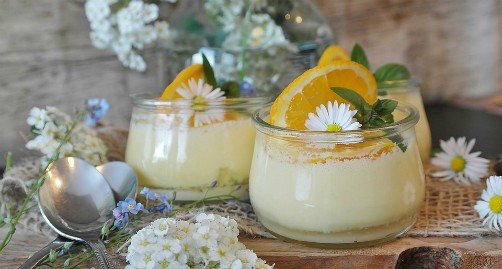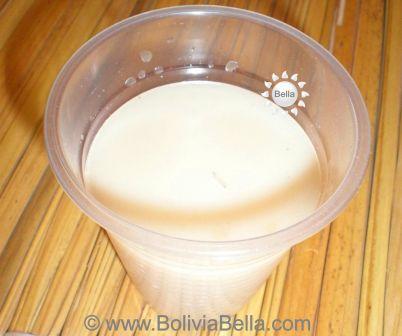Gelatina de pata
literally means "foot jello" or "foot custard". In this case, it is legit cow's foot custard! Now before you make faces and get all grossed out, or start barfing on the spot, let's see what the recipe contains. Seriously, there must be a reason why this is one of the most popular and most loved desserts, not just in Bolivia, but all over South America!

Gelatina de pata is considered not only to be delicious, but also very nutritious and healthy. Bolivian food and recipes often use very unusual ingredients, true. But what is most surprising is how very good some of the Bolivian foods that use these unusual ingredients really are. It's truly surprising how sweet and delicious gelatina de pata actually is.
Ingredients
1 cow's foot (including the hoof and about 10 inches of leg)
3 liters of water (just under 1 gallon)
3 sticks of cinnamon (not powdered cinnamon)
1 cup of evaporated milk (optional, see below)
10 whole cloves (not powdered)
1 tbsp vanilla (optional)
Brown sugar or natural stevia sweetener (about 1/2 cup)
Instructions
Your cow's foot/hoof should be only meat and bone, with the cowhide stripped off of course, and should be very, very clean. In America, you can purchase them in some butcher shops that cater to a more international customer, such as Mexican food markets, or supermarkets where they offer lots of Mexican, Central American or South American foods. Yes, that is how common a food this is in the southern hemisphere. But you might also simply be able to ask at your local supermarket that they reserve one for you.
The cow's foot can be cut into several large pieces if you don't have a very large pot. Cook the cow's foot in the water in a pressure cooker for 2-4 hours, or in a slow-cooker (crock pot) on low for 10-12 hours, until it is very soft and all of the meat has separated from the bone. If you don't have a pressure cooker or a crock pot, you can boil it for 6-8 hours in a regular pot (covered) on medium, but you must make sure to add more water occasionally.
Once the meat has separated from the bone, remove it from heat. Remove all of the bones, cartilage, and meat from the liquid. Set aside for later.
Let your liquid sit at room temperature for one full day, or in the refrigerator for 5-6 hours. You will see a white to yellowish layer of fat begin to form and float to the top of your pot, where it will settle. Once this layer of fat has become solid, use a large spoon or spatula to gently remove it (see? this isn't even fattening). Underneath, you will now find that your water has turned to a sort of clear-ish jello.
This gelatin is 100% natural collagen which, during the boiling time, has been drawn out of the bones and hoof and mixed with the water.
Collagen, which ALL of us have in our bodies, is very healthy to eat. It is actually what causes the elasticity in our skin, and makes our hair and nails strong. As we age, our bodies lose collagen, which is why we begin to wrinkle and our bones, hair and nails become weaker and more brittle. Cosmetic companies use collagen in dozens of skin and hair beauty products for this reason too.
Place half of the collagen substance into a blender, along with ALL of the soft meat, cartilage and only the softest bone pieces. (Leave the other half of the gelatinous collagen in your pot and begin to warm in on the stove while you blend.) Blend the remaining meat and collagen until you have an almost completely smooth liquid (similar in texture to a milkshake or smoothie).

Return it to your pot and mix it into the other half of the collagen. Boil it with the vanilla, cinnamon and cloves for about 1 hour, using a spoon to remove any foam that forms at the top. If you choose to add vanilla, your gelatin de pata will be a slightly darker color. If you choose not to, it will result in a white to off-white custard.
Strain it through a sieve to remove the cloves and cinnamon sticks, leaving only the liquid.
Add the evaporated milk if you'd like your gelatina de pata to be more like a custard and not so much like a jello, and boil for just a few minutes, sweetening to taste with sugar. If you choose not to add the milk, it's not a problem, your gelatina de pata will just be slightly more slippery and gelatinous and less creamy. With the evaporated milk, it will be slightly more like a flan or custard in texture.
Pour into jello/custard molds and refrigerate until firm. We don't normally add anything to our gelatina de pata, but I've seen foreigners occasionally add fruits like blueberries, strawberries and raspberries and even chocolate shavings. I guess that could be yummy!? Just don't add canned fruits or any fruit that is wet or your custard won't set. When it has set, serve very cold.
Bolivians and South Americans know that the gelatinous collagen that cooks out of the cow's foot is very healthy and nutritious. Natural collagen is healthy for kids and they often give it to children who are suffering from malnutrition. However, too much sugar isn't, so you can use natural stevia sweetener like Truvia, if you prefer.
This is not my video and it's in Spanish, but it's very clear and well-made and her recipe seems to be very similar to ours. You can watch the video and follow the instructions above and you'll end up with a batch of perfect cow's foot custard yay!






